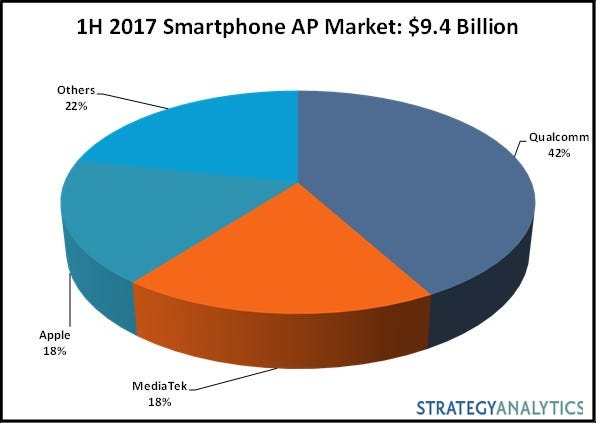The latest smartphone component data from Strategy Analytics reveals that, despite its legal challenges, Qualcomm remains dominant in the smartphone chip market.
October 23, 2017

The latest smartphone component data from Strategy Analytics reveals that, despite its legal challenges, Qualcomm remains dominant in the smartphone chip market.
Applications processors are essentially the CPUs of a smartphone and are represented at Qualcomm by the Snapdragon brand. Qualcomm’s main competitor in this area is Chinese chip maker Mediatek, but after a strong year for the latter in 2016, Qualcomm seems to be pulling away again.
“After a successful 2016, Qualcomm continued its momentum and gained market share with the help of a strengthened portfolio across the board from flagship to mid-range,” said Sravan Kundojjala of SA. “After missing the initial 14 nm FinFET AP wave, Qualcomm made sure it is one of the first companies with a commercial 10 nm smartphone AP.
“Qualcomm’s semi-custom 10 nm flagship 64-bit AP Snapdragon 835, which integrates a gigabit-class LTE modem, has seen greater success than its predecessor Snapdragon 820 / 821. Strategy Analytics believes that Qualcomm is poised for further share gains through 2017 with its strengthened Snapdragon 600-series of APs.”
“MediaTek hit a rough patch in 1H 2017, after registering a robust growth in 2016,” said SA’s Stuart Robinson. “MediaTek’s weak portfolio coupled with increased competition from Qualcomm contributed to its share losses in 1H 2017. MediaTek’s flagship Helio X series has not seen much success so far while the mid-range Helio P series of chips performed strongly.
“Understandably, MediaTek is set to de-emphasis Helio X in favor of Helio P to optimize its investment and to recover market share in 2H 2017. Strategy Analytics believes that MediaTek’s recovery will take time as its modem technology is still generations behind market leader Qualcomm.”
Here’s the SA market 1H 2017 applications processor chart. Apple makes its own APs, as many other vendors like Samsung and Huawei often do too, so Qualcomm has done well to keep such a lead. The legal disputes faced by Qualcomm are largely focused more on its modems, but the AP side of things could still be adversely affected if thing go against it.

About the Author(s)
You May Also Like








.png?width=300&auto=webp&quality=80&disable=upscale)


_1.jpg?width=300&auto=webp&quality=80&disable=upscale)


.png?width=800&auto=webp&quality=80&disable=upscale)